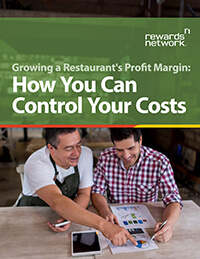There’s one question that’s inevitably on every restaurateur’s mind, whether the market is good or bad:
How do I grow my restaurant profit margin?
Follow along as we narrow in on areas of your business where costs can be controlled to get you to a better bottom line:
- Scheduling staff
- Inventory and food waste
- Restaurant suppliers
- Your menu
Download this free eBook today for over two dozen tips and tricks to drive down your costs and improve your restaurant profit margin.
Excerpt from the Introduction:
When times are tight — or even when they’re not — most restaurateurs need to ask themselves: “Where can I start cutting costs?”
The natural inclination for many business owners is to look at your two biggest expenses — staff and COGS (cost of goods sold) — and slash from the top down, until you can make ends meet. But a savvy restaurateur knows there’s more than one way to skin a salmon.
Making targeted choices about where to cut restaurant costs and where to leave expenses be (no matter how high or low) is a crucial part of maintaining balance in your bottom line. Cut too hastily, and you’ll end up alienating customers with reduced service or missing favorites on your daily menu.
But cut decisively, and you’ll be able to grow your business out of the health of what’s left.
In the following chapters, we’ll be looking at four different areas of your business that can have a significant impact on your ability to control your prime costs: scheduling staff, inventory and food waste, suppliers, and your menu. If you can effectively manage each one of these areas, both your restaurant profit margin and business can grow over time.
There are so many different factors you have to take into consideration when deciding what’s economical for your restaurant. Cost savings and overall expense can be easy to overlook where scheduling comes into play, but how you schedule your staff (your scheduling process and your choices for each shift) can make a big difference to your business success over time.
From service to food quality, scheduling your restaurant staff has critical repercussions on your day-to-day business — and ultimately your bottom line.
So much of the financial aspect of scheduling comes down to figuring out the right amount of people needed for each role in each shift. And yes, overstaffing obviously can have a real impact. Putting too many employees on a shift when the shift needs less means you’ll be paying more in wages than is necessary for that particular day. This type of efficiency is critical for maintaining a reasonable budget for wages.
On top of that, staff members who make most of their money off of tips don’t want to be in an overstaffed shift because they will need to share the limited number of tables available with more servers. Remember, employee turn over gets expensive, so you really don’t want your employees to have an active reason to want to leave.
Believe it or not, understaffing can also lose you just as much money in the long run. Not only can understaffing hinder your employees from providing top notch efficient service (potentially leading to dissatisfied or walkout customers), but consistently understaffing shifts can lead to your employees overcompensating.
Trying to do too much during any one shift can lead to staff members burning out and even becoming resentful of management. Think about what your morale was like in jobs where you felt overworked and underappreciated. That in turn can lead to good employees finding other jobs, which will force you to spend even more money and time hiring new people. Again, turnover should be treated as another expense, one that you want to keep to a minimum.
In many cases, you might be adequately staffing each shift already. But of course, life happens, and it’s not uncommon that for every shift, one or more staff members call in and can’t perform their shift for various reasons (illness, fender bender, etc.), and being understaffed becomes a quick reality.
Make sure to schedule an “on-call” employee for each shift to help make sure you’re always fully staffed in case a regularly scheduled staff member calls in. The on-call employee typically calls in at a designated time before each shift to see if they are needed.
On the flip side, any regularly scheduled employee calling in should also be expected to do so with enough notice to allow management the time needed to get their shift covered. The “on-call” staffing method can apply to both front and back of house.
It’s not just about getting the right number of employees into each shift. It’s also about assigning the right number of staff members into certain roles, which applies to both the front and back of house. For instance, if you have tiers of kitchen staff from line cook to sous chef, you’ll need someone in each of those roles for every shift in order for the kitchen to run smoothly.
It’s a smart idea to schedule newer servers on a shift with more seasoned servers to help them if they get into the weeds. But when it comes to more specialized roles in your restaurant, consider cross training your team. It will give you more flexibility as a manager when it comes to scheduling those roles.
This again comes down to efficiency — you want the right people in the right roles at the right time, so that every shift runs smoothly and every customer leaves happy.
